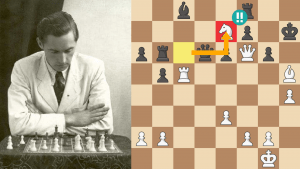
A Rare Line in the Grunfeld
razorblade12 asked:
Ever since I have started playing chess over a year ago, I have always come unstuck when playing against 1.d4 as Black. Is there any defense that you recommend I could use that would suit my style of play?
Dear razorblade:
This is far too general a question. What’s your style? What kinds of positions do you love? What lines have you tried so far and why do you think they failed you? Did you give your openings a chance – it’s normal to lose many games with a new opening while you’re figuring out the pros and cons of it, and what ideas work and which ones don’t. You really need to go through this initial “trial by fire” before making an honest and fair judgment about the system in question.
Here’s a very basic answer:
* Players that seek a quiet, safe, “get everything out in peace” system often go for the Queen’s Gambit (both declined and accepted – 1.d4 d5 2.c4 e6 or 2…dxc4).
* Want to go mainstream – then the sound and highly attractive Nimzo/Queen’s/Bogo Indian is waiting for you to make it your own (1.d4 Nf6 2.c4 e6 3.Nc3 Bb4/3.Nf3 b6/3.Nf3 Bb4+).
* Player’s seeking a closed center with chances for a kingside attack and some tactical thrusts will do well with the King’s Indian (1.d4 Nf6 2.c4 g6 3.Nc3 Bg7 4.e4 d6).
* Like mega-theory and sharp play against the enemy pawn center? Then the Grunfeld is for you (1.d4 Nf6 2.c4 g6 3.Nc3 d5).
* Players that like to mix classical soundness with potentially sharp play and heavy theory enjoy the Slav (1.d4 d5 2.c4 c6 3.Nf3 Nf6 4.Nc3 dxc4) and the Semi-Slav (1.d4 d5 2.c4 c6 3.Nf3 Nf6 4.Nc3 e6).
* Players that like more open positions with chances for a bit of chaos can employ the Budapest Gambit (1.d4 Nf6 2.c4 e5).
* Players that are happy to make a real pawn sacrifice for the initiative and attacking chances should take a look at the Albin (1.d4 d5 2.c4 e5 3.dxe5 d4).
* Looking for something a bit off the beaten path that’s solid, closed, and sound? Give the Stonewall Dutch a try (1.d4 f5 2.c4 e6 3.Nf3 Nf6 4.g3 d5 5.Bg2 c6).
* For those that want an early (but long lasting) positional/dynamic initiative for the minor cost of a pawn will do well with the Benko Gambit (1.d4 Nf6 2.c4 c5 3.d5 b5).
* Those that want a very closed, slow, positional struggle should consider the Czech Benoni (1.d4 Nf6 2.c4 c5 3.d5 e5).
* And those that want a sharp, highly theoretical line that leads to extremely combative situations might fall in love with the Modern Benoni (1.d4 Nf6 2.c4 c5 3.d5 e6 – look at Tal’s early games where he wipes out one grandmaster after another with this opening and you’ll be hot to give it a try).
There are other openings, of course, but this gives you more than enough to grasp onto. Find something that attracts you, learn its typical tactics and ideas, and then leap into the thing. But make sure you give it time, and treat every loss as a learning experience that will eventually make you an expert in your chosen opening.
Turp said (in response to an article where I annotate a beginner’s game):
Sneering and pompous. Humorous to mock lesser-rated players is it? Hmm.
Dear Turp:
Those are rather sophisticated words for a red haired muppet (see his photo). Hmm.
I never mock lower rated players, simply because I don't judge people by their ratings, but by their words and actions. Chess is very much a caste system (when meeting someone, instead of your name they want to know your rating!), but I’m not part of it. Never mistake me for someone that is.
However, it’s important to point out that I’m here to give advice, to teach, and to (if I’m lucky) give the odd laugh to my readers. It’s entertainment. Any and all letters I get will be given a serious look, and I’ll do my best to answer in a manner that is as helpful as possible. But … I also claim license to have a bit of fun with, at times, serious situations (I’m not a Jewish/male Oprah – I won’t cry with you and wring my hands in despair). If we can’t laugh at ourselves, then we’re in serious trouble.
Willilo asked:
I have played the Grunfeld for a long time and have had success with it, but there is a sideline that White can play which is very annoying and seems to give White an advantage every time I play against it. The line goes 1.d4 Nf6 2.c4 g6 3.Nc3 d5 4.Bd2! What should Black do here?
Dear Williko:
This is a very rare move! In fact, it’s not even in the Grunfeld books that I own. In general, Black can try 4…dxc4 and the most natural move, 4…Bg7:
1) 4…dxc4 was seen in V.Ivanchuk - E.Sutovsky, Montreal 2007. Just the fact that a player of Ivanchuk’s stature would play 4.Bd2 gives it some serious cred. Chucky went on to win after (4.Bd2 dxc4) 5.e3 Be6 6.Nf3 c6 7.Ng5 Bd5 8.e4 h6 9.exd5 hxg5 10.dxc6 Nxc6 11.Bxg5 Bg7 12.Bxc4 Nxd4 13.Be3 e5 14.0-0 0-0 15.Rc1 Qb6 16.f4 Rad8 17.fxe5 Bh6 18.Kh1 Bxe3 19.Rxf6 Ne6 20.Qc2 Rd2 21.Qe4 Rd4 22.Qxe3 Rxc4 23.Qe2 Rc5 24.h3 Qc7 25.Re1 Kg7 26.Rff1 Nd4 27.Qf2 Nf5 28.g4 Nh6 29.Qf6+ Kh7 30.Qh4 Rc4 31.Ne4 Kg7 32.Qf6+ Kg8 33.Qh4 Qc6 34.Rf6 Qd5 35.Rd6 Qa5 36.e6 fxe6 37.Rxe6 Rc6 38.Rxc6 bxc6 39.a3 Kg7 40.Kg2 Qd5 41.Qe7+ Rf7 42.Qd6 Ng8 43.Qxd5 cxd5 44.Nc5 a5 45.Re8 Ne7 46.b4 axb4 47.axb4 d4 48.Rd8 g5 49.b5 Rf6 50.Rd7 Kf7 51.Ne4 Rb6 52.Rxd4 Ke6 53.Nc3 Rb8 54.Kg3 Rc8 55.Rd3 Ke5 56.b6 Rc4 57.b7 Nc6 58.Nd5 Nb8 59.Nb6 Rb4 60.Rd8 Rb3+ 61.Kg2 Rb2+ 62.Kf1 Rb1+ 63.Ke2 Nc6 64.b8Q+ Nxb8 65.Rxb8 Rb2+ 66.Kd1 Ke4 67.Re8+ Kd4 68.Nd7 Rh2 69.Rh8 Ke3 70.Nc5 Rd2+ 71.Ke1 Rc2 72.Re8+ Kf3 73.Ne6 Kg3 74.Rh8 Rc6 75.Nxg5 Kf4 76.Rg8, 1-0. However, I’m sure there are all sorts of improvements here, though by the time the position after 18.Kh1 was reached, Black was definitely much worse. Oddly, I remember seeing a detailed analysis of this game somewhere, but being ancient and burned out, I can’t remember where. Frustrating!
2) 4…Bg7 is the move most would choose, when 5.cxd5 Nxd5 6.e4 Nb6 (6…Nxc3 7.Bxc3 has also been seen, but 6…Nb6 has a better reputation) we get a position that usually occurs after 4.cxd5 Nxd5 5.Bd2 Bg7 6.e4 Nb6. There’s actually a lot of analysis on this, so I won’t repeat all of it (Yelena Dembo covers this position in her excellent book, PLAY THE GRUNFELD [2007], and it's also covered in the slightly newer [2009] CHESS EXPLAINED: THE GRUNFELD by Bogdanov).
After 7.Be3 0-0 White has tried all sorts of moves, though we’ll only focus on 8.Bb5!? and 8.Be2 (I should mention that another popular move, 8.f4, can also be reached by a very different move order: 3.f3 d5 4.cxd5 Nxd5 5.Nc3 Bg7 6.e4 Nb6 7.Be3 0-0 8.f4. In this case Black has shown that he gets adequate play by 8…Nc6! 9.d5 Nb8 when he can slap white’s center with moves like …e5 or ...c6):
1) 8.Bb5
The idea is that in some lines, after 8…a6 9.Be2, the b6-square can become weakened.
8…Qd6
8…Be6 was the big move a couple years back, but suddenly 8…Qd6 became the hot choice among grandmasters.
9.Nge2
Better than 9.Nf3, which allows a pin by 9…Bg4. D.Akdag - M.Antonsen, Silkeborg 2009 continued (after 9.Nf3 Bg4) 10.e5 Qb4 11.Qc2 Nd5 12.a3 Qa5 13.Qd2 Bxf3 14.gxf3 Nxc3 15.Be2 f6 16.exf6 Bxf6 17.bxc3 c5 18.h4 cxd4 19.Bc4+ Kh8 20.Bxd4 Nc6 21.h5 g5 22.Rb1 Qxa3 23.Rxb7 Nxd4 24.cxd4 Qxf3, 0-1.
9…a6 10.Bd3 Rd8 11.0-0 Nc6 12.d5 Ne5 13.Bc2 and now both 13…Nbc4 and 13…e6 give Black good play.
2) 8.Be2 Nc6 9.Nf3
Worse is 9.d5 Ne5 10.Bd4 c5! 11.Bxc5 Nec4 12.Bxc4 (12.Bxb6 Qxb6 13.Bxc4 Qxb2 and 12.Qb3 Nxb2 13.Qxb2? Na4 would delight Black) 12…Nxc4 13.Qb3 Nxb2! 14.Qxb2 Qc7 15.Bb4 a5 16.Nge2 axb4 17.Qxb4 Bg4 and Black was better in G.Kacheishvili - P.Svidler, Szeged 1994.
9…Bg4 10.d5 Bxf3 11.gxf3
11.Bxf3 Ne5 12.Be2 Nec4 13.Bc1 c6 is fine for Black.
11…Ne5 12.Qb3 c6 13.f4 Ned7 14.dxc6 bxc6 15.0-0-0 e6 and though computers tend to experience machine-ecstasy for white’s position, grandmaster practice has shown that Black is actually doing very well.
So 4.Bd2 pretty much leads to a hotly contested variation that usually arrives from 4.cxd5 Nxd5 5.Bd2. The lines I gave should enable you to achieve the usual Grunfeld counterplay.






